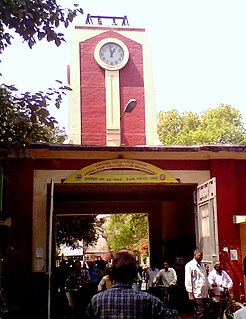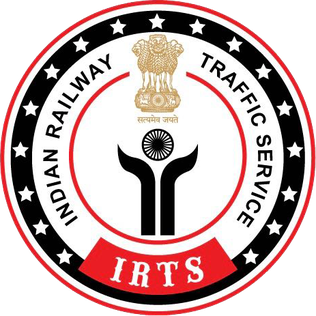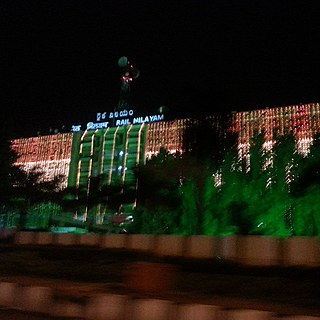Special Class Railway Apprentice (SCRA) was a programme by which candidates are selected by the Union Public Service Commission (UPSC) India, to train in the undergraduate program in mechanical engineering at the Indian Railways Institute of Mechanical and Electrical Engineering, Jamalpur. This programme started in 1927 and is one of the oldest in India.
The Indian military services have established numerous academies and staff colleges across India for the purpose of training professional soldiers in military sciences, warfare command and strategy, and associated technologies.

The Jamalpur Gymkhana, often referred to as Gymkhana by its members, is a hostel for young apprentice officers of the Indian Railways in Jamalpur, Bihar, India. It is also a club like any other Gymkhana. The difference is that membership to this club is restricted only to those who spend their formative years in its corridors. It is difficult to talk about Gymkhana without quickly moving on to the anecdotal history of its members - current and past, referred to as Gymmies by its inmates.
The Indian Railways Institute of Mechanical and Electrical Engineering (IRIMEE), was founded in 1888 as a technical school and commenced training Mechanical Officers for Indian Railways in 1927. It is the oldest of the five Centralised Training Institutes (CTIs) for training officers for Indian Railways. IRIMEE is located at Jamalpur in the Munger district of Bihar, on the Patna-Bhagalpur rail route. IRIMEE provides theoretical and practical training for a four-year undergraduate degree in mechanical engineering as well as professional courses to officers and supervisors of Indian Railways. There are also courses for non-railway organizations and foreign railways.
The Indian Railway Service of Mechanical Engineering (IRSME) is one of the group 'A' central engineering service of the Indian railways. The officers of this service are responsible for managing the Mechanical Engineering Division of the Indian Railways.IRSME officers are drawn from the Combined Engineering Service Examination (ESE) conducted by Union Public Service Commission. All appointments to the Group 'A' services are made by the President of India.[7]
The Engineering Services Examination (ESE) is conducted to recruit officers for the services which cater to the technical functions of the Government of India in the field of engineering. Many candidates take the exams, competing for a limited number of posts. Officers are selected by the union government on the recommendation of the Union Public Service Commission (UPSC). A three-stage competitive examination, the Engineering Services Examination (ESE), is conducted by the UPSC for recruitment to the Engineering Services.

Jamalpur Locomotive Workshop was established on 8 February 1862. Jamalpur Workshop was the first full-fledged railway workshop facilities in India, set up by the East Indian Railway.

The National Academy of Indian Railways (NAIR), Vadodara formerly Railway Staff College is a Centralised civil service training institute along with being engineering training institute and medical training institute for for Group A and B Officers of Indian Railways (IR), headed by a Director General and manned by an faculty of experienced Railway Managers and Experts. Starting with the initial training of Officers Trainees inducted into all the 10 organised Group A Central Civil Services, Engineering and Medical Services that form the Management Cadre of Indian Railways, the Academy also conducts, mid-service mandatory or theme based in service Management Courses for all Officers of IR and courses for Officers of other Group A Central Services, Public Sector and Foreign Railways. The Academy is housed in the sprawling 55 acres campus of the Pratap Vilas Palace at Lalbaug, Vadodara.
Indian Railways Institute of Electrical Engineering (IRIEEN), Nashik was set up by the Indian Railways at Nashik in Maharashtra for imparting training to newly appointed officers of Indian Railway Service of Electrical Engineers (IRSEE), recruited through Engineering Services Examination conducted by UPSC, New Delhi. The Institute was set up in the year 1988 at Nashik, Maharashtra. The Institute is headed by the Director. He is assisted by a team of Nine faculty members, who are having practical experience as well as technical qualifications.
The Centralised Training Institutes of the Indian Railways has eight constituent institutes. The Indian Railways is the largest civilian employer in the world at approximately 1.6 million employees. Around 12000 officers form the line and staff management. Training of all the management cadres is entrusted and shared between these eight institutes.
Indian Railways Institute of Civil Engineering (IRICEN), Pune is the training institute for the Civil engineers of the Indian Railways. The institute had a modest start in 1959 as the Permanent Way Training School for training entry level Civil engineers. It is now a Centralised Training Institute and trains officers of the IRSE cadre of the Indian Railways.
The Indian Railway Service of Electrical Engineers (IRSEE) is one of the group A central service of the Indian railways. The officers of this service are responsible for managing the Electrical Engineering organisation of the Indian Railways.
The Indian Railway Service of Signal Engineers (IRSSE) is a group A cadre of the Indian railways. The officers of this service are responsible for managing the Signal and Telecommunications Engineering Organization of the Indian Railways.

The Indian Railway Traffic Service, abbreviated as IRTS is a Group 'A' Central Civil Service Cadre of the Government of India. IRTS in its present form was reconstituted in 1967. The IRTS Cadre functions under the Administrative Control of the Ministry of Railways, Government of India. The officers of this service are responsible for administering Railway Transport in the country. On one hand, IRTS officers co-ordinate among various technical departments of the Indian Railways, while on the other hand, they form the public interface of the Indian Railways. Colloquially called Traffic Officers, they are the primary facilitators of Railway services right from Planning of freight movement, Passenger transport, Passenger amenities to Station Management and Infrastructure Planning.
The Indian Railway Accounts Service is one of the Group A Central Civil Service of the Government of India. The Officers of this Service are responsible for the Accounts and Finance Management of the Indian Railways. About 25-30 IRAS officers are recruited every year through Civil Services Examination conducted by Union Public Service Commission. At present, the IRAS Cadre has a Strength of about 800 Officers.
Karmaveer Kakasaheb Wagh Institute of Engineering Education & Research, Nashik (KKWIEER) is the oldest engineering college in Nashik.

College of Military Engineering (CME) is a premier technical and tactical training institution of the Indian Army Corps of Engineers of the Indian Army. Training of Combat Engineers, Military Engineering Service, Border Roads Engineering Services (BRES) and Survey done here.

The Central Public Works Department of India, commonly referred to as the CPWD, is a premier Central Government authority in charge of public sector works. The Central Public Works Department, under the Ministry of Urban Development now MoHUA, deals with buildings, roads, bridges, flyovers, complicated structures like stadiums, auditoriums, laboratories, bunkers, border fencing, border roads, etc. CPWD came into existence in July 1854 when Lord Dalhousie established a central agency for execution of public works and set up Ajmer Provincial Division. It has now grown into a comprehensive construction management department, which provides services from project conception to completion, and maintenance management.

Ashwani Lohani is a retired officer of Indian Railway Service of Mechanical Engineers. He has earlier worked as the Chairman & Managing Director of Air India and the former Chairman of the Railway Board of Indian Railways.

Rail Nilayam is a landmark building in Hyderabad that is the zonal headquarters of the South Central Railway zone of the Indian Railways. It is located near the Marredpally neighbourhood of Secunderabad, Telangana, India.








